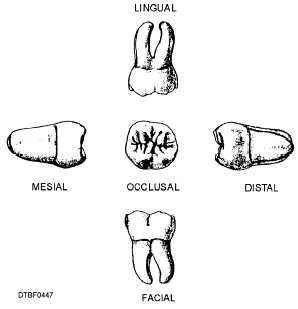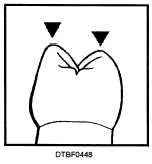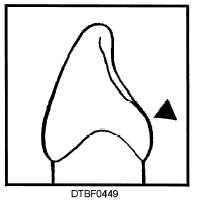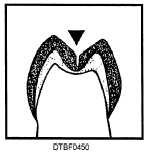and second molars is that the occlusal surface of the second molar has no fifth cusp.
Roots - The mandibular second molar has two roots that are smaller than those of the first molar.
MANDIBULAR THIRD MOLAR
The mandibular third molar (tooth #17 or #32), illustrated in figure 4-47, is the eighth tooth from the midline. It appears in many forms, sizes, and shapes. Since its function is similar to that of the other two mandibular molars, its general appearance is the same. It has smaller surfaces, more supplemental grooves, and four or five cusps, which are not so sharply differentiated as those of the first two molars.
Roots - The roots, generally two in number, are shorter in length and tend to be fused together. In many instances they show a distinct distal curve.
GLOSSARY OF UNIQUE DENTAL ANATOMY
The following list will be helpful to you in understanding some of the anatomical terms used in this chapter.

Figure 4-47. - Surfaces of mandibular third molar.
Cusp - A pointed or rounded elevation of enamel found on cuspids and on the chewing surfaces of bicuspids and molars.

Cingulum - Found on the lingual aspect of an anterior tooth. It is a convex mount of enamel localized to the cervical one-third of the crown.

Fissure - A linear fault that sometimes occurs in a developmental groove by incomplete or imperfect joining of the lobes. A pit is usually found at the end of a developmental groove or a place where two fissures intersect.

Fossa - A rounded or angular depression of varying size found on the surface of a tooth.
Continue Reading
